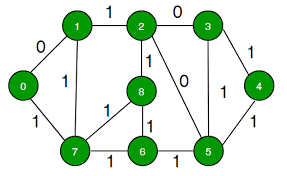소개
0-1 BFS는 가중치가 0, 1로 주어진 그래프에서 최단경로를 찾아낼 수 있는 알고리즘입니다. 최단경로 알고리즘에는 다익스트라 알고리즘을 사용할 수 있지만, 시간 복잡도가 또는 인 반면에, 0-1 BFS는 의 시간 복잡도로 문제를 해결할 수 있습니다.
일반적인 BFS 탐색과 동일하지만, 가중치가 0인 정점이 존재하기 때문에 실제로 정점의 방문 횟수가 더 많더라도 가중치가 더 낮은 경우를 고려해야합니다. 그렇기 때문에 결과 값이 방문 횟수의 최소가 아닌 가중치의 최소인 경우를 찾기 위해서는 가중치가 낮은 경로부터 탐색해야합니다.
.jpg)
정점 1에서 정점 2로의 이동 = 방문 횟수 1, 가중치 1
정점 1에서 정점 3, 4를 거쳐 정점 2로의 이동 = 방문 횟수 3, 가중치 0
가중치가 낮은 정점으로의 이동을 높은 우선 순위로 해야하기 때문에, 덱의 가장 앞단(front)에 삽입합니다. BFS와 동일하게 간선의 갯수(E)만큼 탐색을 하게되고, 정점의 갯수(V)만큼 중복없이 방문하기 때문에 시간 복잡도는 로 동일합니다.
예제
https://www.acmicpc.net/problem/13549
import java.io.*;
import java.util.Arrays;
import java.util.LinkedList;
public class Main {
public static int[] check;
public static void main(String[] args) throws IOException {
try (BufferedReader reader = new BufferedReader(new InputStreamReader(System.in));
BufferedWriter writer = new BufferedWriter(new OutputStreamWriter(System.out))) {
String[] s = reader.readLine().split(" ");
int n = Integer.parseInt(s[0]);
int k = Integer.parseInt(s[1]);
check = new int[100001];
Arrays.fill(check, -1);
bfs(n, k);
writer.write(check[k] + "");
}
}
public static void bfs(int n, int k) {
LinkedList<Integer> queue = new LinkedList<>(); // deque
queue.offer(n);
check[n] = 0;
while (!queue.isEmpty()) {
int position = queue.poll();
if (position == k) {
return;
}
if (position * 2 <= 100000 && check[position * 2] == -1) {
queue.addFirst(position * 2); // 높은 우선순위
check[position * 2] = check[position];
}
if (position > 0 && check[position - 1] == -1) {
queue.offer(position - 1);
check[position - 1] = check[position] + 1;
}
if (position < 100000 && check[position + 1] == -1) {
queue.offer(position + 1);
check[position + 1] = check[position] + 1;
}
}
}
}현재 정점(x)에서 2배만큼의 정점(2x)으로 이동하는 가중치는 0입니다. 다른 정점으로의 이동(-1 or +1)보다 가중치가 낮으므로 우선 순위가 높아야하기 때문에 덱의 가장 앞단(front)에 삽입하여 문제를 해결할 수 있습니다.
https://www.acmicpc.net/problem/1261
import java.io.BufferedReader;
import java.io.IOException;
import java.io.InputStreamReader;
import java.util.LinkedList;
public class Main {
public static int[][] graph;
public static int[] dx = {-1, 0, 1, 0};
public static int[] dy = {0, 1, 0, -1};
public static void main(String[] args) throws IOException {
try (BufferedReader reader = new BufferedReader(new InputStreamReader(System.in))) {
String[] s = reader.readLine().split(" ");
int n = Integer.parseInt(s[0]);
int m = Integer.parseInt(s[1]);
graph = new int[m][n];
for (int i = 0; i < m; i++) {
String line = reader.readLine();
for (int j = 0; j < n; j++) {
graph[i][j] = Character.getNumericValue(line.charAt(j));
}
}
bfs();
}
}
public static void bfs() {
LinkedList<int[]> queue = new LinkedList<>(); // deque
queue.offer(new int[]{0, 0, 0});
graph[0][0] = -1;
while (!queue.isEmpty()) {
int[] poll = queue.poll();
int x = poll[0];
int y = poll[1];
int c = poll[2];
if (x == graph.length - 1 && y == graph[0].length - 1) {
System.out.println(c);
return;
}
for (int i = 0; i < dx.length; i++) {
int nx = x + dx[i];
int ny = y + dy[i];
if (nx < 0 || ny < 0 || nx >= graph.length || ny >= graph[0].length) {
continue;
}
if (graph[nx][ny] == 0) { // 방
queue.addFirst(new int[]{nx, ny, c}); // 높은 우선순위
} else if (graph[nx][ny] == 1) { // 벽
queue.offer(new int[]{nx, ny, c + 1});
}
graph[nx][ny] = -1; // 방문 처리
}
}
}
}벽(1)을 부수고 이동하는 경우는 가중치가 1만큼 증가하지만 방(0)으로 이동하는 경우는 가중치는 0입니다. 방으로 이동하는 것이 벽으로 이동하는 것보다 가중치가 낮으므로 우선 순위가 높아야하기 때문에 덱의 가장 앞단(front)에 삽입하여 문제를 해결할 수 있습니다.

